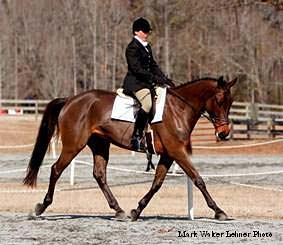Eventing, also known as Combined Training, originated as a test of a Cavalry horse and rider. It is composed of three different tests: Dressage, Cross County, and Stadium Jumping. The same horse and rider perform all three tests in successive order in each competition.
Dressage
 Dressage is a test of a horse’s obedience and suppleness while being ridden on the flat without any jumping efforts. Originally a test of the Cavalry horse on the parade ground, in this test a horse and rider must perform prescribed movements in a ring measuring 20 by 60 meters, with each movement scored form 0 to 10. In Dressage, a 10 is perfection and almost unheard of; most marks range from 4 to 7. The Dressage score is then converted to a penalty score, with scores usually ranging from 25, a very good score, to over 50; lower scores are better, as in golf. The Dressage penalty score is then brought forward as the base score for the rest of the competition.
Dressage is a test of a horse’s obedience and suppleness while being ridden on the flat without any jumping efforts. Originally a test of the Cavalry horse on the parade ground, in this test a horse and rider must perform prescribed movements in a ring measuring 20 by 60 meters, with each movement scored form 0 to 10. In Dressage, a 10 is perfection and almost unheard of; most marks range from 4 to 7. The Dressage score is then converted to a penalty score, with scores usually ranging from 25, a very good score, to over 50; lower scores are better, as in golf. The Dressage penalty score is then brought forward as the base score for the rest of the competition.
Cross Country
 Cross Country is a jumping test. In this test, the horse and rider are required to jump over obstacles similar to what a Cavalry horse would encounter trying to deliver a message on the battlefield. Some of these obstacles include logs; banks; ditches; jumps into, through, and out of water; hedges; gates; or a combination of any of these things.
Cross Country is a jumping test. In this test, the horse and rider are required to jump over obstacles similar to what a Cavalry horse would encounter trying to deliver a message on the battlefield. Some of these obstacles include logs; banks; ditches; jumps into, through, and out of water; hedges; gates; or a combination of any of these things.
Cross Country is relatively easy to score, with horse and rider being penalized for refusing to jump a fence, falling, or being too fast or too slow in reference to an an optimum time set for the course. Refusing to jump a fence incurs 20 penalty points, falls incur elimination and 0.4 time faults are added for each second outside the allowable time window. Additionally, while the rider can walk the course ahead of time, the horse has never seen any of the fences before jumping them.
Stadium Jumping
 Stadium Jumping or Show Jumping is another jumping test. In this test, the horse and rider jump fences in a ring. This again tests the horse’s boldness as well as the agility that the horse and rider exhibited in the dressage, as the fences are on related strides, and the horse must be rebalanced between the fences in order to jump properly.
Stadium Jumping or Show Jumping is another jumping test. In this test, the horse and rider jump fences in a ring. This again tests the horse’s boldness as well as the agility that the horse and rider exhibited in the dressage, as the fences are on related strides, and the horse must be rebalanced between the fences in order to jump properly.
Scoring for Stadium Jumping is similar to Cross Country in that refusals (4 points), and falls result in elimination. Additionally 4 points are added for knocking a rail from a fence. Time can also be a factor, with 1 penalty point for each second over the optimum time.
Horse Trials & Three-Day Events
Most competitions are called Horse Trials and are similar to a 10k road race; they are not all that stressful if you are in good shape, and they are a good place to practice technique. However, a few times a year at the upper levels of competition (Preliminary, Intermediate, and Advanced), there are Three Day Events.
These competitions are the highlight of the season. Three Days (as they’re often called) have the same 3 phases as Horse Trials, except that they are actually spread out over three days (most horse trials take place over a one or two-day period) and are supposed to be more difficult. Some of the differences in a true Three-Day-Event include:
Also on the first and last day there is a test of the horse’s fitness and soundness.
Not everyone or every horse will compete at a Three Day Event. It takes years of hard work and dedication, and it takes a very special horse to be able to deal with all the training and competition requirements needed to make it to a Three Day.